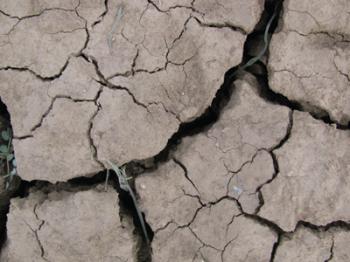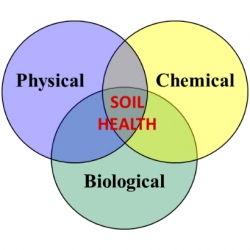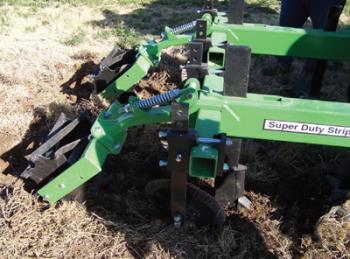Soil Health

What is Soil Health?
Soil health is the capacity of the soil to function effectively and provide ecosystem services on a sustainable basis. A healthy soil not only supports crop production, but is less prone to erosion.
What is the Importance of Soil Health?
Soil provides an important ecosystem service that supports crop production, of which humans and many animals rely on for subsistence. Since there is a heavy reliance on soil health, careful management is essential to sustain a soil's utility.
In the past, conventional commercial farming depended on management of soil nutrients to promote adequate crop yields. This resulted in the development of precise nutrient analytical methods with accompanying recommendations to address nutrient deficiencies in different that are used for farming. However, scientists now know that managing soils for nutrients may not lead to sustainable crop production. Other factors of the soil need to be addressed to attain the goal of sustainable crop production.
These factors include chemical, physical, and biological attributes of the soil. Chemical components refer to the nutritional aspect of the soil. Soil physical aspects include physical support of crops; hence, issues such as root growth and proliferation are closely related to he physical component of the soil. Biological components that include living and dead organic entities in the soil, are the least known of the three components.
It is important to remember that soil health is an attempt to bring together the chemical, physical, and biological aspects of the soil with the understanding that they are interrelated and that they must operate in synergy for optimum and sustainable soil function.
Chemical attributes include:
-
Macronutrients
-
Micronutrients
-
Salinity/Sodicity
-
Toxicity
Physical attributes include:
-
Texture
-
Structure
-
Soil Water
-
Soil Density
Biological attributes include:
-
Organic Matter Content (Total and Active)
-
Soil Organisms (Abundance/Diversity)
-
Soil Organisms (Activity)
-
Soil Pathogens

How to Build Soil Health
In healthy soils, physical, chemical, and biological processes and functions drive the productivity of the soil. An important component of the soil that integrates these three aspects is the soil organic matter. The majority of soils in New Mexico have very low soil organic matter levels, and such soils are prone to degradation and erosion. Therefore, soil management strategies should be focused on returning organic matter that is sufficient to maintain or improve crop productivity and biological activity to the soil. The following are suggested methods to improve soil health in New Mexico.
-
Reduced or minimized tillage. Soil organic matter is rapidly lost when practicing conventional tillage methods. This involves turning the soil over the plow depth and exposes large quantities of soil organic matter to oxidation. With reduced tillage methods, such as no-till, strip-till or zone-till, smaller quantities of soil organic matter is oxidized, which leads to more organic matter in the soil profile over a long period of time. For more information about reduced tillage, see Reduced Tillage in Arid Regions.
-
Cover cropping and green manure. Cover crops are planted between cash crops to protect the soil from erosion and improve soil health and fertility. Green manures are grown solely during the cropping season to supply soil fertility, suppress weeds, and improve soil health. Green manure systems may be important in organic production systems since those systems rely solely on organic sources of nutrients for crop production. There are several cover crops and green manures that grow well in New Mexico. For more information on cover cropping systems in New Mexico, see Cover Crops.
-
Crop rotation. Good crop rotation can mitigate soil-borne diseases and improve soil health. It is usually a better farming practice to alternate crops of different families from season to season or year to year.
-
Organic amendments. Organic amendments can help build up the soil organic matter and consequently improve the overall soil quality. Many materials are available as organic amendments, including manure, compost, and guano, among others. It is important to know the nutrient composition of the amendment material because the nutrient levels vary among amendments. A good practice is to send the organic material to a laboratory for analysis so as determine the quantity of amendment to add to the soil for meeting plant nutrient demands that cannot be supplied by the soil itself.
-
Chemical amendments. Chemical amendments are often based on soil analysis. Soil analysis, along with fertilizer recommendations, will help a grower apply the correct amount of nutrients to the soil.


What are the Challenges When Building Soil Health?
Reduced tillage can be challenging to implement, especially when new tillage tools become necessary, and may require considerable financial outlay. However, through careful thinking, planning, and consultation with experts, growers can work out adaptable reduced tillage practices on their farms.Cover crops are abundant in New Mexico; however, the availability of water is a major consideration in the adaptation and choice of cover crops/green manure.
Organic amendments require soil analysis before an amount of amendment can be added to the soil. Be aware that adding large quantities of compost with only modest concentrations of nutrient elements can add significantly to the soluble salt level in the soil. Chemical amendments also require soil analysis due to the varying amounts of nutrients in soils. Without it, either insufficient or excessive amounts of nutrient can be added, and this can reduce farm profit.